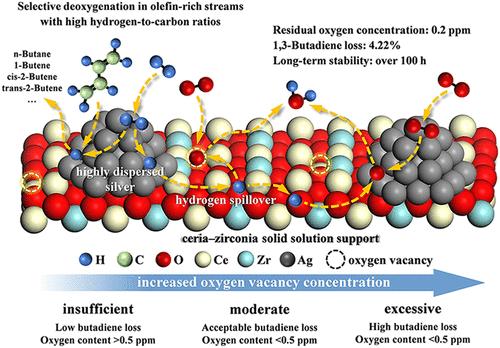Tuning Oxygen Vacancies in Ag/Ceria-Zirconia for Selective Trace Oxygen Removal from Olefin-Rich Streams with High Hydrogen-to-Carbon Ratios
IF 3.9
3区 工程技术
Q2 ENGINEERING, CHEMICAL
引用次数: 0
Abstract
The selective removal of trace oxygen remains challenging in olefin-rich gas streams with high hydrogen-to-carbon ratios, particularly in the efficient utilization of refinery dry gas (RDG) resources. In this contribution, a highly selective and durable silver-based catalyst supported on ceria–zirconia was rationally designed and synthesized for the selective removal of trace oxygen under olefin-rich conditions with high hydrogen-to-carbon ratios. Among the prepared catalysts, the Ag/Ce0.75Zr0.25O2–CC catalyst synthesized via the complexation–precipitation method selectively reduces oxygen to 0.2 ppm at 150 °C while maintaining a low 1,3-butadiene loss of 4.2% under simulated RDG conditions. Detailed physicochemical characterizations revealed that the catalyst’s outstanding performance is attributed to the highly dispersed Ag species and a moderate concentration of oxygen vacancies, which synergistically promote selective oxygen activation and removal. Furthermore, the balanced oxygen vacancy concentration and weak surface acidity of the support effectively suppress the undesired hydrogenation of 1,3-butadiene. The catalyst also demonstrated long-term stability over 100 h of continuous operation, highlighting its potential for industrial application. These findings offer valuable insights into industrial deoxygenation strategies, particularly for olefin-rich process streams.

调整Ag/Ceria-Zirconia的氧空位以选择性去除高氢碳比富烯烃流中的痕量氧
在高氢碳比的富烯烃气流中,选择性去除微量氧仍然是一个挑战,特别是在炼油厂干气(RDG)资源的有效利用方面。合理设计和合成了一种高选择性和耐用的铈锆负载银基催化剂,用于在高氢碳比的富烯烃条件下选择性去除痕量氧。在所制备的催化剂中,通过络合沉淀法合成的Ag/ Ce0.75Zr0.25O2-CC催化剂在150 ℃条件下选择性地将氧还原到0.2 ppm,同时在模拟RDG条件下保持低的1,3-丁二烯损失4.2%。详细的物理化学表征表明,催化剂的优异性能归功于高度分散的Ag和中等浓度的氧空位,它们协同促进了氧的选择性活化和去除。此外,平衡的氧空位浓度和载体的弱表面酸度有效地抑制了1,3-丁二烯的不良加氢反应。该催化剂还表现出超过100小时连续运行的长期稳定性,突出了其工业应用潜力。这些发现为工业脱氧策略提供了有价值的见解,特别是对于富含烯烃的工艺流。
本文章由计算机程序翻译,如有差异,请以英文原文为准。
求助全文
约1分钟内获得全文
求助全文
来源期刊

Industrial & Engineering Chemistry Research
工程技术-工程:化工
CiteScore
7.40
自引率
7.10%
发文量
1467
审稿时长
2.8 months
期刊介绍:
ndustrial & Engineering Chemistry, with variations in title and format, has been published since 1909 by the American Chemical Society. Industrial & Engineering Chemistry Research is a weekly publication that reports industrial and academic research in the broad fields of applied chemistry and chemical engineering with special focus on fundamentals, processes, and products.
 求助内容:
求助内容: 应助结果提醒方式:
应助结果提醒方式:


